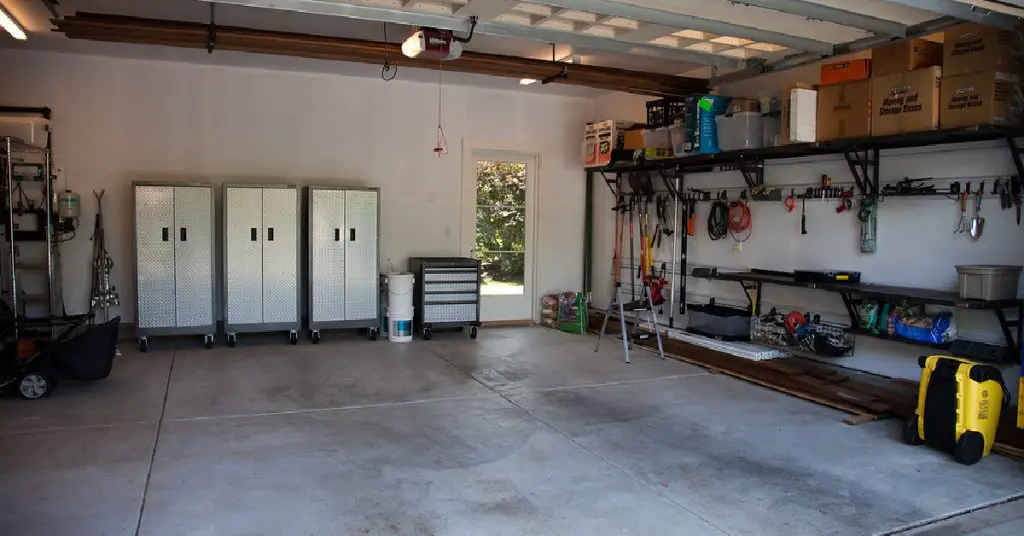Proper wood storage is essential for any woodworker or DIY enthusiast. Whether you’re working on large projects or just keeping a stockpile for future use, knowing how to store wood in your garage can save you time, money, and headaches. In this comprehensive guide, we’ll explore the best practices for how to store wood in garage, from organization tips to protection methods.

Key Takeaways:
- Keep wood elevated and well-ventilated
- Control humidity (35-55%)
- Organize by size and type
- Protect from sunlight and moisture
- Use wall-mounted or vertical storage solutions
- Prevent pest infestation
Why Proper Lumber Storage Matters
Proper lumber storage isn’t just about keeping things organized; it’s about preserving the quality and longevity of your wood. Here are a few key reasons why you should prioritize proper storage:
Reason 1: Prevents Warping and Splitting
Fluctuations in temperature and humidity can cause wood to warp and split, rendering it unusable for your projects. By storing your lumber in a controlled environment and following best practices, you can minimize the risk of these issues.
Reason 2: Protects Against Moisture and Pest Damage
Moisture and pests are two of the biggest threats to your lumber. Damp conditions can lead to rot, mold, and fungal growth, while insects like termites and beetles can burrow into and destroy your wood. Proper storage helps keep your lumber dry and pest-free.
Reason 3: Maintains Quality and Longevity
Well-stored lumber retains its structural integrity and dimensional stability, ensuring that your projects turn out as intended. Properly cared for, high-quality wood can last for decades, making it a worthwhile investment.
5 Best Practices for How to Store Wood in Garage
Garages can be less-than-ideal environments for storing lumber, but with the right precautions, you can make it work. Here are some best practices to follow how to store wood in garage:
1. Keep Wood Off the Ground
One of the most important rules for storing wood is to keep it off the ground. This prevents moisture absorption and allows for proper air circulation. Here are some ways to elevate your wood:
- Use pallets or skids
- Install wall-mounted racks
- Build a custom storage system with 2x4s and plywood

2. Ensure Proper Air Circulation
Good air flow is essential for preventing moisture buildup and maintaining wood quality. To promote air circulation:
- Leave space between stacked boards
- Use stickers (small strips of wood) between layers
- Avoid storing wood in airtight containers or plastic bags
3. Control Humidity Levels
Maintaining the right humidity level in your garage is crucial for wood storage. Aim for a relative humidity between 35% and 55%. Consider these tips:
- Use a dehumidifier in damp climates
- Install a hygrometer to monitor humidity levels
- Ensure proper ventilation in your garage
4. Organize by Size and Type
Efficient organization makes it easier to find the right piece of wood when you need it. Try these organizational methods:
- Sort boards by length and width
- Group wood types together (e.g., hardwoods, softwoods, sheet goods)
- Label shelves or bins for quick identification
5. Protect from Sunlight and Heat
Direct sunlight and extreme heat can cause wood to dry out, warp, or crack. To protect your wood:
- Store wood away from windows
- Use curtains or blinds to block sunlight
- Consider insulating your garage to regulate temperature
4 Lumber Storage Solutions for Your Garage
Now that we’ve covered the basics, let’s explore some specific storage solutions for your garage:
1. Wall-Mounted Lumber Racks
Wall-mounted racks are an excellent space-saving solution for storing long boards and planks. They keep wood off the ground and allow for easy access.
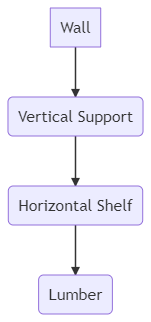
2. DIY Wall-Mounted Rack
You can build a simple wall-mounted rack using the following materials:
- 2×4 lumber for the frame
- 1/2″ plywood for support brackets
- Heavy-duty screws and bolts
Follow these steps:
- Attach vertical 2x4s to wall studs
- Create L-shaped brackets from plywood
- Secure brackets to the vertical 2x4s
- Add horizontal 2x4s for additional support
3. Vertical Storage Solutions
For smaller spaces or to store sheet goods like plywood, vertical storage is an efficient option.
4. Pivoting Sheet Goods Rack
A pivoting rack allows easy access to large panels while maximizing floor space. Here’s a basic design:
- Build a rectangular frame with 2x4s
- Attach casters to the bottom for mobility
- Install a pivot point on one end to allow the rack to swing out
- Add dividers or pegs to separate sheets
5. Mobile Lumber Cart
A mobile lumber cart combines the benefits of horizontal and vertical storage while offering flexibility in your workspace.
6. DIY Mobile Lumber Cart
To build a basic mobile lumber cart:
- Construct a sturdy base with 2x4s and plywood
- Add vertical supports for sheet goods
- Install horizontal shelves for lumber storage
- Attach heavy-duty casters for mobility

7. Scrap Wood Storage Ideas
Don’t forget about those valuable scraps! Here are some ideas for organizing smaller pieces:
- Use plastic bins or buckets sorted by size or wood type
- Build a wall-mounted cubby system
- Create a rolling cart with multiple compartments
8. Overhead Storage
Take advantage of your garage’s vertical space by installing overhead racks or shelves. This keeps your lumber out of the way while freeing up floor space for other activities.
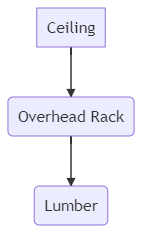
9. Scrap Wood Organization
Don’t neglect your scrap wood! Invest in bins, drawers, or wall-mounted racks to keep small pieces organized and easily accessible.
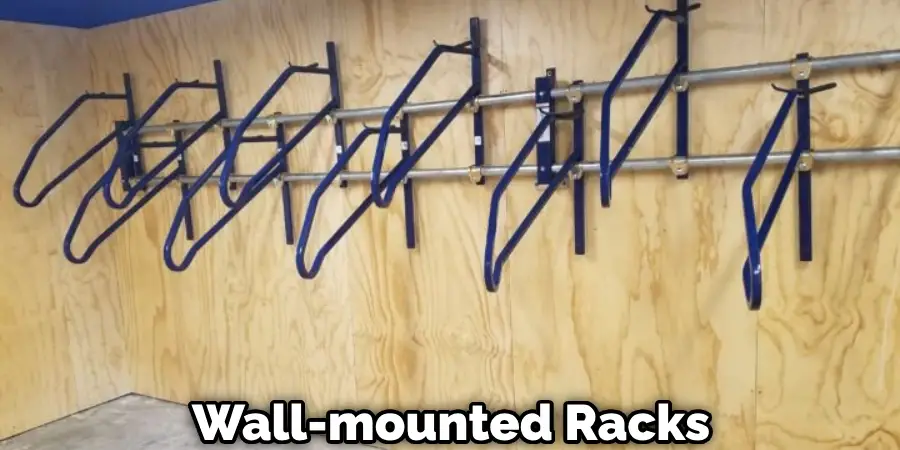
4 Tips for Maximizing Space
Even with the best storage solutions, garage space can be limited. Here are some tips for making the most of what you have:
1. Use Overhead Storage
As mentioned earlier, overhead storage is a great way to utilize vertical space and keep your lumber out of the way.
2. Install Wall Mounts or Pegboards
Wall mounts and pegboards are perfect for storing tools, hardware, and smaller pieces of wood, freeing up floor and shelf space for larger items.
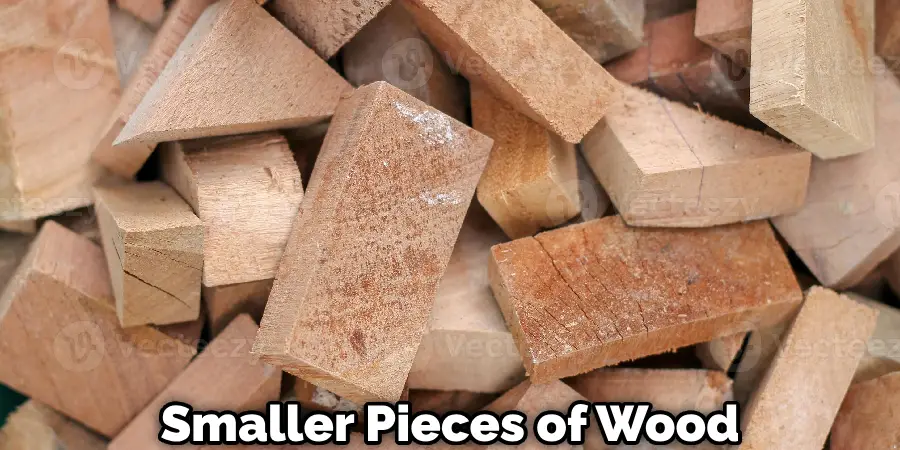
3. Utilize Pull-Out Drawers or Bins
Pull-out drawers or bins under shelves or workbenches can provide additional storage for scraps, hardware, and other small items.
4. Keep Your Storage Area Clean and Organized
Regularly decluttering and organizing your storage area will make it easier to find what you need and maximize available space.
Protecting Your Wood from Moisture and Pests
1. Moisture Control
Moisture is one of the biggest threats to stored wood. In addition to keeping wood off the ground and ensuring proper air circulation, consider these tips:
- Use a moisture meter to check wood before storage
- Apply a sealant to end grains to prevent moisture absorption
- Store wood away from water heaters or areas prone to leaks
2. Pest Prevention
Insects and rodents can quickly damage stored wood. To protect against pests:
- Inspect wood for signs of infestation before storage
- Use natural repellents like cedar blocks or essential oils
- Consider treating wood with a borate solution for long-term storage
Seasoning Firewood in Your Garage
If you’re storing firewood in your garage, proper seasoning is crucial for efficient burning. Here are some tips:
- Stack firewood in a single row with space between logs for air circulation
- Keep firewood at least 5 inches off the ground
- Allow 6-12 months for proper seasoning
- Use a moisture meter to check for readiness (ideal moisture content is 20% or less)
FAQs About How to Store Wood in Garage
What is the Best Way to Store Timber in a Garage?
To store timber in a garage, use overhead storage racks to save space and keep the lumber dry. Install wall mounts or pegboards to keep tools within reach, and use pull-out drawers for smaller pieces. Keep the area clean to prevent moisture and insect damage, and consider using stickers between stacked boards for air flow. Additionally, store sheet goods vertically on a lumber cart to save space and protect them. These simple steps will ensure that your timber stays well-organized and in good condition for future use.
Is It Ok to Store Logs in Garage?
Storing logs in a garage can be suitable if certain precautions are taken. Ensure the garage is dry, well-ventilated, and that the logs are elevated to prevent moisture absorption and pest infestation. Fire safety measures and adherence to local regulations are also crucial. Always consider these factors to ensure safe and optimal storage conditions.
What is the Best Way to Store Wood?
Storing wood properly is crucial for maintaining its quality and preventing decay. Whether indoors or outdoors, the wood should be kept in a dry, well-ventilated area, elevated off the ground, and covered to shield it from the elements. When stacking wood outdoors, a crisscross pattern is recommended to ensure stability and airflow. It’s important to inspect the wood regularly for signs of decay or pest infestation, and to control pests to maintain its quality for future use.
Will Wood Warp in a Garage?
In a garage, wood can take on a mind of its own, bending and twisting due to humidity and uneven drying. This dance is influenced by the room’s temperature, the thickness of the wood, its type, and how the grain runs. These elements play a role in the wood’s moisture balance, which in turn affects how quickly it adjusts to its surroundings and its likelihood of bending out of shape.
You can keep warping at bay by choosing lumber with a straight grain and no signs of warping, and by storing it correctly. Warping can take many forms, including bowing, crooking, kinking, cupping, and twisting, each presenting its own set of challenges when it comes to correcting the warp or using the wood. Consider a 2’ x 3’ dresser top made of pine, crafted from 2×4 lumber. This type of lumber is typically not dried in a kiln, and the choice of softwood can make it more prone to warping. However, letting the wood dry out and adjust to its environment before using it can help keep warping in check.
How Do You Store Large Amounts of Wood?
Storing large amounts of wood, such as lumber, requires careful considerations to maintain quality and prevent damage. Proper air flow is crucial for air-drying lumber, and unseasoned wood should be stored outdoors, away from direct sunlight and rain, and off the ground to prevent moisture absorption. Seasoned wood or kiln-dried lumber is best kept indoors, ideally in a workshop, garage, shed, or storage unit. Additionally, protecting wood from the elements and ensuring sufficient air circulation are essential for maintaining its integrity over time.
Does Wood Warp in Garage?
Wood stored in a garage can warp due to fluctuating temperatures and high humidity. To prevent this, it’s important to condition the wood by storing it in a stable, low-humidity environment for at least a month before use. Additionally, constructing with potential wood movement in mind and ensuring proper ventilation during storage can help minimize the risk of warping.
Is It Okay to Store Wood in a Garage?
It’s generally okay to store wood in a garage, but precautions should be taken. Ensure the wood is well-seasoned to deter pests, use stickers to prevent moisture-related issues, and be mindful of potential pests, especially in warm and humid climates.
How Do You Store Lumber Indoors?
When storing lumber indoors, it’s essential to keep pathways clear, stack the lumber securely, and store it in a well-ventilated area to prevent damage from moisture and insects. Additionally, consider using stickers to allow for proper ventilation between boards. Storing lumber outdoors should be avoided if possible, but if necessary, ensure it is covered to protect it from excess moisture and sun damage, and keep it off the ground to prevent rot and damage from insects. Following these guidelines will help maintain the quality of the lumber until it’s ready for use.
Can You Store Wood Furniture in an Unheated Garage?
Storing wood furniture in an unheated garage poses risks such as moisture-related damage, temperature fluctuations, and pest infestations. It’s advisable to consider climate-controlled storage or take precautions like using a vapor barrier, elevating furniture off the ground, and avoiding plastic covers to protect the furniture from potential damage in an unheated garage. Taking these measures can help preserve the quality of the furniture while in storage.
How to Store Plywood in a Garage?
To store plywood in a garage, choose a dry area away from direct sunlight and moisture, elevate the plywood using pallets or a shelf to prevent moisture absorption, stack the sheets horizontally with support at both ends, ensure adequate ventilation to prevent moisture buildup, and cover the plywood with a breathable material such as a tarp or plywood storage rack to protect it from dust.
Conclusion
Properly storing wood in your garage is an investment in your future projects. By following these guidelines and implementing smart storage solutions, you’ll ensure that your lumber stays in top condition and is readily available when inspiration strikes. Remember to regularly inspect your wood storage area and make adjustments as needed to maintain the best possible conditions for your valuable materials.


